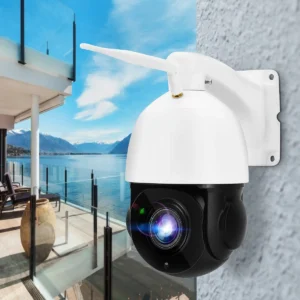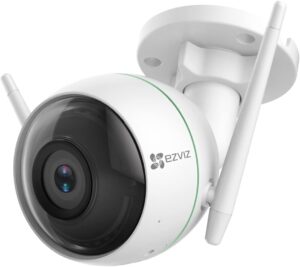10 CCTV Camera Types & Their Uses
10 Types of CCTV Systems & Their Uses. Choosing the right Closed-Circuit Television (CCTV) system is critical in today’s security-conscious world. Whether for your home, business, or a public area, understanding the types of CCTV systems available can empower you to make informed decisions about your security infrastructure.
With technological advancements, most security cameras have evolved far beyond simple surveillance, offering features like remote access, high-definition video, and motion detection.
Let’s dive into the various security camera types and their specific uses to help you find the perfect fit for your security needs.
1. IP CCTV Cameras
IP (Internet Protocol) CCTV systems or network cameras are digital video security cameras that use the internet to transmit image data and control signals over a fast Ethernet link to a network video recorder (NVR). These cameras are known for their superior video quality compared to traditional analog systems.
Key Benefits:
- High-resolution images that offer greater detail and wider coverage areas.
- The ability to easily expand and scale the system as needed.
- Support for advanced features like motion detection, night vision, and remote access.
Ideal Uses:
IP CCTV systems are best suited for areas that require high-quality video surveillance. They are particularly effective in environments where detail is critical, such as monitoring retail spaces, protecting sensitive areas in corporate buildings, or overseeing crowded public spaces.
Their flexibility in installation and scalability makes them a top choice for modern security needs, allowing for comprehensive coverage of large areas with fewer cameras.
Additionally, the capability to access footage remotely offers the convenience of monitoring your property from anywhere in the world, making IP systems ideal for those who need to keep an eye on their assets while on the move.
2. Wireless CCTV Cameras
Wireless CCTV cameras offer flexibility and ease of installation, making them popular for home and business security. Unlike their wired counterparts, a wireless security camera transmits video footage over Wi-Fi, eliminating the need for coaxial cables.
Key Benefits:
- Easy to install and relocate, offering flexibility for various surveillance needs.
- Less intrusive, with no need for drilling or cabling through walls.
- Enables remote access to live and recorded video via internet-connected devices.
Ideal Uses:
- Best for areas where wiring is impractical or for temporary surveillance setups.
- Suitable for renters as home security cameras or those looking for a security solution that can easily move with them.
- Ideal for small businesses and homes that require a straightforward, adaptable security system.
3. HD Surveillance Cameras
HD surveillance cameras capture high-definition video footage, providing superior image clarity and detail over standard-definition cameras. These cameras are essential for identifying faces, license plates, and other critical details in security footage.
Key Benefits:
- Offers high-resolution video footage, making it easier to identify individuals and objects.
- Improved low-light performance compared to standard-definition cameras.
- Enhanced digital zoom capabilities without significant loss of detail.
Ideal Uses:
- Critical areas require detailed video footage, such as entry points and high-security zones.
- Retail stores to monitor customer activity and deter theft with clear image quality.
- Any environment where identification and detail are paramount for security purposes.
4. Pan Tilt and Zoom (PTZ camera) CCTV
PTZ CCTV cameras are versatile and dynamically controlled, allowing operators to pan (move horizontally), tilt (move vertically), and zoom in on specific areas for detailed surveillance.
Key Benefits:
- Provides comprehensive coverage with the ability to remotely adjust the camera’s field of view.
- Optical zooming capabilities allow for close-up views without compromising video quality.
- Ideal for monitoring large areas with the need for occasional focused observation.
Ideal Uses:
- Large public spaces like parks, parking lots, and marketplaces where wide and specific area surveillance is required.
- Business premises that require flexible viewing angles and the ability to focus on incidents in real time.
- High traffic areas where the situation demands rapid adjustments to the camera’s focus or field of view.

5. Infrared Night Vision Cameras
Infrared night vision cameras use IR LEDs to illuminate their field of view, allowing them to capture clear video footage in complete darkness. This technology makes them indispensable for continuous surveillance, regardless of lighting conditions.
Key Benefits:
- Clear footage in total darkness, ensuring round-the-clock security.
- Often equipped with motion detection, enhancing their utility during nighttime.
- Some models feature color night vision, providing detailed video even in low light.
Ideal Uses:
They are perfect for areas requiring 24/7 monitoring, such as around building perimeters, parking lots, and any outdoor areas with limited or no lighting, making them ideal outdoor security cameras. They are also suitable for indoor areas like warehouses and storage rooms that may not always be well-lit.

6. Day and Night CCTV
Day and night CCTV cameras are designed to provide optimal video quality under varying light conditions. They can switch from color video during the day to black and white at night, ensuring clarity and detail regardless of the time. The footage is sent to a digital video recorder for storage.
Key Benefits:
- Versatile functionality adapts to changing light conditions without manual intervention.
- Provides consistent surveillance coverage both during the day and at night.
- Enhanced sensitivity to light allows for clear images in both high and low-light environments.
Ideal Uses:
Ideal for locations that experience wide variations in lighting, such as retail stores, office buildings, and outdoor spaces that receive natural light during the day but rely on artificial lighting at night.
7. Dome CCTV Cameras
Dome CCTV cameras are named for their dome-shaped housing, making it difficult for onlookers to determine where the camera points. This feature, combined with their discreet appearance, makes the dome camera popular for indoor and outdoor surveillance.
Key Benefits:
- Vandal-resistant design protects the camera from tampering and damage.
- Aesthetically pleasing and unobtrusive, blending easily with various architectural styles.
- Wide-angle lenses offer comprehensive coverage, reducing the number of cameras needed for full surveillance.
Ideal Uses:
- Especially suited for public areas like shopping malls, restaurants, and lobbies where security and aesthetics are important.
- Their vandal-resistant feature is ideal for high-risk areas prone to tampering or vandalism.
8. Bullet CCTV
Bullet CCTV cameras are named for their distinctive long, cylindrical shape, resembling a bullet. These cameras are known for their ease of installation and the ability to cover a long distance, making them ideal for outdoor use.
Key Benefits:
- High-quality video footage over long distances.
- Visible design acts as a deterrent to potential intruders.
- Often equipped with features like infrared night vision for clear footage in low light conditions.
Ideal Uses:
Bullet cameras are best used when surveillance of a specific, fixed area is required, such as monitoring entrances, parking lots, and long, narrow spaces. Their weather-resistant design makes them suitable for outdoor monitoring, providing reliable security coverage regardless of environmental conditions.
9. C-Mount Surveillance Cameras
C-mount surveillance cameras allow changeable lenses to fit different surveillance needs, offering the flexibility to cover greater distances or wider areas by simply switching the camera lens.
Key Benefits:
- Adjustable field of view with interchangeable lenses.
- Capable of supporting high-definition video quality.
- Robust design suitable for both indoor and outdoor use.
Ideal Uses:
C-mount cameras are versatile and can be used in a variety of settings, from monitoring large, open spaces like warehouses and parking lots to focusing on smaller, specific areas. They are particularly useful in environments where surveillance needs might change, requiring different focal lengths to capture the desired footage effectively.
10. Miniature Cameras
Miniature cameras, also known as spy or covert cameras, are designed for discreet surveillance. These compact devices can be hidden in everyday objects, making them nearly invisible to the unsuspecting eye.
Key Benefits:
- Highly discreet, allowing for covert monitoring without detection.
- Flexible placement options due to their small size.
- Suitable for both wired and wireless configurations.
Ideal Uses:
Miniature cameras are ideal for situations that require unobtrusive surveillance, such as monitoring employee behavior, protecting sensitive areas of a business, or gathering evidence without alerting the subject of surveillance.
10 Types of CCTV Systems & Their Uses, their small size and versatility make them perfect for indoor use, especially in settings where traditional cameras would be too conspicuous or impractical.

